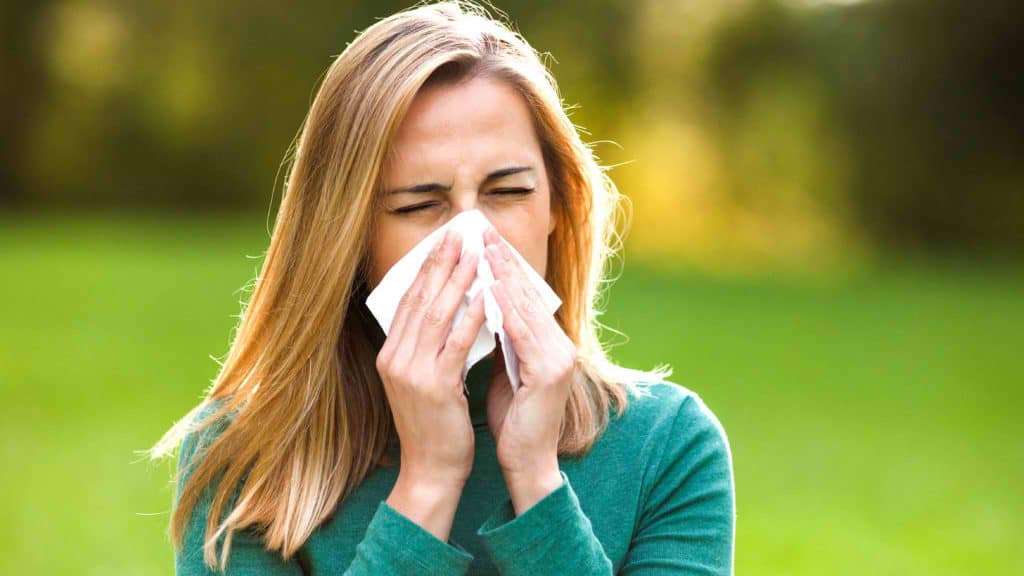
The spring allergy season is hitting much of the country especially hard — and researchers are blaming climate change for more intense pollen counts.
There’s been a spike in the number of people suffering seasonal allergies, also called hay fever or allergic rhinitis, for the first time, and people in the northwest and southwest are getting the worst of it, according to the American Academy of Allergy, Asthma and Immunology.

Not only are more people experiencing the symptoms of burning, itchy eyes and runny nose or congestion, allergy seasons overall — including spring and fall — are lasting as much as 27 days longer than in the past.
Warmer, wetter winters may be one reason why. Rising temperatures, changes in worldwide weather patterns and increasing airborne pollen levels for a longer period of time can even affect the healthy; for those with a family history of allergies, the result is a more intense allergic reaction, according to a recently released report by the academy.
“Some research has suggested that the warming trend that we have in our environment is causing the pollen seasons to start a little bit earlier, and extend a little bit longer,” said Dr. Stanley Fineman, former president of the American College of Allergy, Asthma and Immunology. “Consequently, patients are suffering because they’re exposed to pollen, for longer periods of time.”
‘ALLERGY EXPLOSION’
Millions of Americans are experiencing what allergist Dr. Clifford Bassett calls an “allergy explosion.”
“Climate change, globalization, air pollution, and over-sanitization of the environment in the early years of life are just a few of the causes that, taken together, have introduced new germs into our environment are causing needless suffering.” said Bassett, medical director of Allergy & Asthma Care of New York.
Currently, oak, maple, and birch trees — the “big bad” pollen makers — are producing the powdery substance at higher rates simultaneously with poplar, alder and ash. Other allergic triggers include, fragrant flowers and flowering weeds, like dandelions.
The tree pollen storm was captured earlier this week by a New Jersey man in a video post on Facebook that has been viewed more than 4 million times. In the video, Eric Henderson of Millville, New Jersey taps a large tree with his frontloader and the pollen explodes in an ominous greenish-yellow cloud.
Henderson’s wife, Jennifer, shared it on her Facebook page.
“We don’t suffer from allergies, but my son does something fierce,” Jennifer Henderson told NBC News via email. “Our Claritin supply has certainly increased in the house!”
Bassett recommends starting an over-the-counter or prescription antihistamines like Zyrtec or Claritin, or a nasal steroid for nasal congestion about one or two weeks before allergy season starts. That can prevent “allergy priming” and lessen or eliminate symptoms, Bassett said.
If the problem is severe, an allergy specialist can develop an individualized plan, he said.
Other than medications, there are ways to minimize the misery of pollen season:
WEAR OVERSIZED OR WRAP-AROUND SUNGLASSES.
They block the airborne pollen that causes redness from entering your eyes and lids.
WEAR A HAT.
Preferably a wide brimmed one. Hair gels can turn your head and hair into a pollen magnet, pollen adheres and is easily transferable to your bedding, sheets and pillows.
DON’T HANG WET OR DAMP CLOTHING ON THE “LINE.”
Use a dryer to prevent pollen from sticking to your clothes.
BEAT THE CLOCK.
Consider exercising indoors on very high pollen days (especially if you are sensitive to seasonal pollen present in the air). Higher levels of pollen are usually found on warm, dry and windy days and lower pollen counts on windless, wet and cloudy days.
KNOW YOUR POLLEN COUNT.
Pollen levels often rise on windy, dry and sunny days and lower on wet, rainy and still days. Check your local weather reports to identify peak allergy days.
CONFIRM YOUR SEASONAL ALLERGY DIAGNOSIS.
Is it allergies or a cold, or something else? In-office allergy tests can help pinpoint sensitivities and allow a more tailored and successful treatment plan.
“If I could tell people one thing it’s to be prepared,” said Bassett. “Have an allergy tool kit, not just with your medication, but equipped with sunglasses, a cap, and nasal saline too.”

